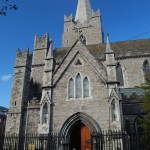Saint Patrick’s Cathedral in Dublin
The St Patrick’s Cathedral is the most famous and biggest temple in Ireland. Officially it is called The National Cathedral and Collegiate Church of Saint Patrick and, strictly speaking, does not have status of a cathedral because a long time ago it ceased to have the seat of a bishop but unofficially it maintains the significance of the main temple of the country.
The outstanding role of the St Patrick’s Cathedral in the life of Ireland has much to do with its rich past. Tradition has it that on the site where the cathedral stands today Saint Patrick (around 370/380-461), enlightener and Baptizer of Ireland baptized the first dweller of the Green Island. In memory of this event a wooden church was built here, which, however, left no traces at all; the only essential evidence of the events that happened a long time ago is a stone with a Celtic cross carved on it found near the cathedral in 1901.
The St Patrick’s Church existed on this spot all the way until the Anglo-Norman invasion. It was one of the four parish churches of then-Dublin and was called “Saint Patrick an Insula” –– Saint Patrick on the Island, since it stood on an island formed by two branches of the Poddle River.
The English invasion in the second half of XII century opened a new era in the history of Ireland. The first Anglo-Norman bishop of Dublin John Comyn in 1191 raised the St Patrick’s Church up to the status of a collegiate church, i.e., a church with a body of canons –– capitul –– without official status of a cathedral, and built the Archbishop’s palace near it. In this way Comyn intended to create a new independent center of spiritual authority in contrast with the old Irish clergy of Dublin having the Christ Church Cathedral as its base. Comyn’s decision was confirmed by Roman Pope Celestin III’s bulla in the same year.
The old St Patrick’s Church was no longer up to the standard of its new status, and the archbishop began to reconstruct it. The renewed temple was dedicated in 1192, while in the beginning of XIII century –– the exact date unknown but still in Comyn’s lifetime –– officially received status of a Cathedral. In this way a foundation was laid of parallel existence of two cathedrals in Dublin: unprecedented fact. Historians believe that the St Patrick’s Church by Comyn’s idea was supposed to assume functions of the cathedral but the clergy of the Christ Church claiming the present tradition were in strict opposition of it. Acute conflict that began soon entered a stage of a chronic one and ended only in 1870 when the Christ Church became the cathedral temple for joined dioceses of Dublin, Glendagul and Kildar, while Saint Patrick received status of a national collegiate church and a representative of every Irish diocese was a member of its capitul.
Under Archbishop Henry London, John Comyn’s successor, construction of a new Saint Patrick Cathedral began. The means for that were given by English kings John the Lackland (1199-1216) and Henry III (1216-1272). Besides that, in 1225, dozens of monks were sent to all the ends of Ireland to gather offerings. Construction of the new church took up around 30 years. It was built in early English Gothic style. The temple was dedicated in 1254, and in 1270 archbishop Falk Soundford attached a chapel of Holy Virgin to its eastern part; it became the only significant addition to the building in its entire history.
Pages: 1 2

